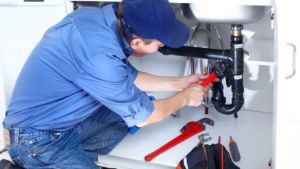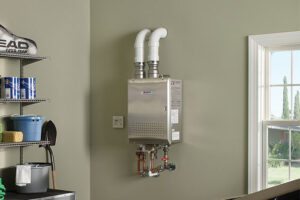Westfield Plumbing deals with the distribution of clean water and the removal of sewage. It is different from process piping, which handles chemicals, gases, and other substances used in manufacturing.
Plumbing requires manual dexterity, good analytical problem-solving skills, and interpersonal communication. It also requires a detailed understanding of pipe materials and construction techniques.

The water distribution system provides the bulk of a community’s infrastructure for delivering consumers high-quality, pressurized, potable water. It comprises pipes, pumps, tanks, and other hydraulic components that link treatment facilities with water taps. The typical drinking water distribution system includes:
These winding, interconnected networks provide a steady supply of fresh water to homes and businesses and support other community uses, including landscape irrigation and fire suppression. From an operational standpoint, the primary challenge of a distribution system is maintaining safe and reliable service to consumers under normal operating conditions and in the event of an emergency or disaster.
A primary concern is microbial contamination, which occurs through the growth of organisms in the distribution system and their interaction with material, sediment, and disinfectant residuals. Ideally, a distribution system must be operated and maintained to ensure microbial contamination does not compromise the water quality delivered to the end-users.
Another challenge is ensuring that water pressures are consistent throughout the distribution network. If the system operated without a buffer, customers closer to the source would receive lower pressures than those farther away. To help mitigate these differences, the plumbing industry has developed several systems that optimize water distribution pressures through design, operation, and maintenance techniques.
One such approach is a grid network where pipelines are interconnected to form a network. This configuration reduces the amount of head loss due to pipe lengths by eliminating dead ends. It also enables professionals to isolate sections of the distribution system for maintenance and repairs without disturbing water flow.
Various materials are used to construct these networks, with ductile iron and pre-stressed concrete being the most common today. Polyvinyl chloride (PVC) and reinforced plastic are also widely used. Steel and asbestos cement pipes are no longer available in new construction. However, they continue to be used in existing systems.
Codes and standards establish the minimum size of water distribution piping that must be installed in residential and commercial buildings. These standards are based on several factors, including friction losses, piping material properties, capacity, and water-pressure limitations in the building. In addition to establishing minimum piping sizes, codes and standards address the requirements for cross-connections between non-potable water sources and potable piping in the distribution system.
Many people need to think about where plumbing waste goes when they flush a toilet or use the garbage disposal. But it’s important to know how your system works so you can avoid clogged pipes and other issues.
Most plumbing waste is directed to a municipal sewer system. However, some homes have independent septic tanks that treat household plumbing waste. In these systems, the wastewater percolates through brick or concrete block walls of a cesspool into the ground. Anaerobic bacteria are treated in a tank to remove contaminants like nitrogen, phosphorus, and grease.
Alternatively, some houses have macerators, which transfer bathroom and kitchen waste to existing waste pipes by breaking down and softening waste. They work by churning or cutting waste into small particles and are often used in areas where underground pipes cannot easily transport large amounts of garbage.
The waste is then pushed into the drainpipes and the sewer system, where it’s sent to a treatment plant. It’s treated to reduce the amount of nutrients it contains and to kill any remaining bacteria. Afterward, it’s discharged into the environment.
While it’s tempting to throw things like chicken bones and egg shells into the disposal, these items can build up in the pipes and cause blockages. It’s also best to store cooled cooking oils and fats in containers, such as empty food cans or paper bags, rather than pouring them down the drain. This can help prevent a clogged drainpipe and the potential for costly repairs.
If you have a garbage disposal, be sure to clean it regularly. Most units have a rotating brush that can help break up any larger pieces of food. It’s also a good idea to keep the disposal on a low setting when using it, as high-powered spinning blades can damage the motor.
If you’re concerned about your septic tank or sewer system, call a plumber for help. A professional can handle the volume of sewage and sediment that needs to be moved, de-water it, and then dispose of it safely in an approved location.
A home or business’s heating and cooling systems use plumbing to convey water and other fluids to and from appliances, fixtures, and storage tanks. To ensure they function properly, plumbing engineers and technicians install, maintain, and repair these piping networks. They may also assist in the design and layout of these systems for new construction projects.
Plumbing fixtures include water closets (also known as toilets), urinals, bidets, bathtubs, showers, sinks, and washing machines. These devices use pipes, valves, and traps to function. The drainpipes and venting pipes in the plumbing system help to keep wastewater separate from freshwater supplies, preventing contamination of drinking water.
Plumbing is a trade that often requires on-call shifts for emergencies, which can interfere with personal schedules. This can lead to less time with family and friends and additional stress on a person’s physical health. Some plumbers choose to be self-employed and work for themselves, which can provide greater flexibility in scheduling and choice of projects. However, this requires more specialized training and extensive industry knowledge. It also makes it more difficult to find steady work.
The plumbing system is critical in providing clean, safe water and removing waste. It is complex yet vital to our daily lives. It is often taken for granted until a problem occurs, such as a leak or clog. Regular maintenance can prevent problems and keep your home running smoothly.
Leaking pipes, clogged drains, and broken fixtures are just a few of the issues that can arise if not properly maintained. To avoid these problems, having your plumbing system inspected and serviced regularly by a qualified plumber is important.
Plumbers can inspect your plumbing for various issues, including cracks, corrosion, and clogs. They can also test your water pressure and make recommendations based on the results.
Regular plumbing maintenance can save you money in the long run. It can also help prevent major repairs and extend the life of your plumbing system. By having your plumbing system inspected and serviced regularly, you can catch small problems before they become big problems.
Plumbing systems are used daily and are subject to wear and tear. Over time, this can lead to wear and tear and leaking pipes or clogged drains. If left unattended, these issues can lead to expensive repairs and even structural damage to your home.
The primary function of plumbing is to supply clean water for consumption, washing, and cooking. It can also remove waste from the home. The plumbing system comprises pipes, valves, fixtures, and appliances installed to convey water and remove waste.
In Canada, plumbing systems are regulated by provincial and territorial governments. Plumbers must be licensed to work in the field and adhere to strict guidelines to ensure customers’ safety.
Plumbing has been around for centuries and plays an essential role in our daily lives. It connects us to one of the most precious resources on earth, allowing us to wash, cook, drink, and bathe safely. Without our plumbing systems, we would not be able to thrive.

